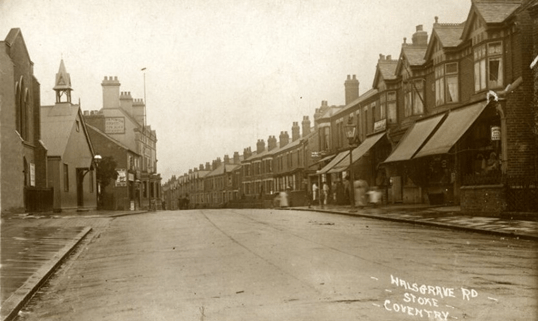John Marshall of Stoke Local History Group tells the story of a former congregational chapel.
In the 19th century the area we now call Ball Hill was little more than a small hamlet, sometimes known as Stoke Knob and noted for two distinctive features – a pub, which still exists, and a congregational chapel.
The congregational chapel was a neat, red-brick building, opened in 1836 and serving a largely rural community of farm workers and weavers. It was originally a branch of the Vicar Lane chapel in the centre of Coventry and its origins reflected the widespread influence of non-conformism during this period.
Non-conformist groups – including Baptists, Methodists and Quakers, as well as Congregationalists – had become a significant force within Coventry by the late 18th century and their influence later spread to the city’s outlying areas, including Stoke.

Congregationalists first established a foothold in Stoke when a Sunday School was formed at Stoke Row in 1813. This became the genesis of the new chapel at Ball Hill, which in 1851 had seating for around 170 people and also ran a popular Sunday School. The building was described as being in plain Gothic style with three lancet windows at the front, and was built in the 1830s at the expense of the Vicar Lane congregation, led by its influential pastor, the Rev John Sibree.

The photograph above shows the chapel building in about 1906, with its Band of Hope marchers in front. This was a time of rapid urban expansion in Stoke and the picture gives a clue about what was happening. On the far left is a building being demolished, to make way for the construction of another new street in the district, in this case Marlborough Road. And beside the chapel is a vacant plot of land with a notice in front, announcing that a new chapel building is to be constructed on this site.
When this photograph was published by David Fry and Albert Smith in the second volume of their book, The Coventry We Have Lost, in 1993, they assumed, understandably enough, that a new chapel was planned for the empty site because the old chapel’s days were numbered. From the evidence in this photograph, they assumed that the old chapel was about to be demolished, along with the adjoining buildings in the picture, to allow Marlborough Road to be built. But this turned out not to be true.
A new chapel was indeed built on the vacant plot but this was not a replacement for the original chapel but an addition to it. The fact is that Stoke Congregational Chapel was no longer large enough to serve the expanding community of Stoke and more space was needed. This need was fulfilled by a new “temporary” structure which sat beside the old chapel and turned out to be little more than a corrugated iron building which, remarkably, still survives to this day.
For a number of years both chapel buildings at Ball Hill continued to sit side-by-side, busily serving the social, educational and religious needs of the immediate community. Aside from worship, activities at the Stoke chapel included a girls’ sewing guild, a men’s social club and a ladies’ sewing class, as well as the regular Sunday School. A painting by Sydney Bunney in 1928 (below) gives an impression of what the two buildings looked like.

But even in 1907, when the temporary ‘tin tabernacle’ was first constructed, there was an awareness that a bigger single building would eventually be required. A document in 1913, unearthed from Coventry Archives, explains that the original church had successfully served the area for 70 years but by the early 1900s “the startling growth of Coventry had completely revolutionised the village of Stoke” and the new iron building was no more than a stopgap before a new site could be found.
The 1913 document states: “We have at present about 400 scholars on the roll and the two buildings are filled on Sunday afternoons, often to overflowing, and the chapel has to be used for worship and Sunday School, as well as for many other gatherings.”
Accordingly, a new building fund was established in 1910 and after much effort – even during the war years – sufficient money was raised to build a new church in Harefield Road, which eventually opened in 1929. This building remained in use until 2016 when the congregation merged with the Ansty Road United Reformed Church.

But what happened to the old buildings left behind at Ball Hill after the move to Harefield Road? We know that the temporary iron building became a retail outlet and many local residents will remember it as a motor cycle showroom, a bed shop or a hardware store. It is now an all-purpose grocery shop. And the original chapel? Was it finally demolished in 1929, having escaped that fate in 1907? Apparently not, it seems.
Research by Jabet’s Ash has discovered that the old chapel site immediately became home to a gents’ outfitter, and was listed in a street directory of 1931-32 as number 74a Walsgrave Road. It continued to be listed as a gents’ outfitter for a number of years and was under the proprietorship of Harold Williams between 1960 and at least 1970.

These days, although largely ignored and looking nothing like the original chapel, the building appears to be still in existence and now operating – much disguised – as a Subway sandwich shop. Any careful glance at this building will reveal its peculiar but distinctive shape, its lack of a conventional first floor, and even the original red bricks, which are still just visible behind its current pebbledash exterior. What could this building be, other than the shell of the old Ball Hall chapel?
● This article first appeared in the November issue of Jabet’s Ash, the newsletter of Stoke Local History Group.
